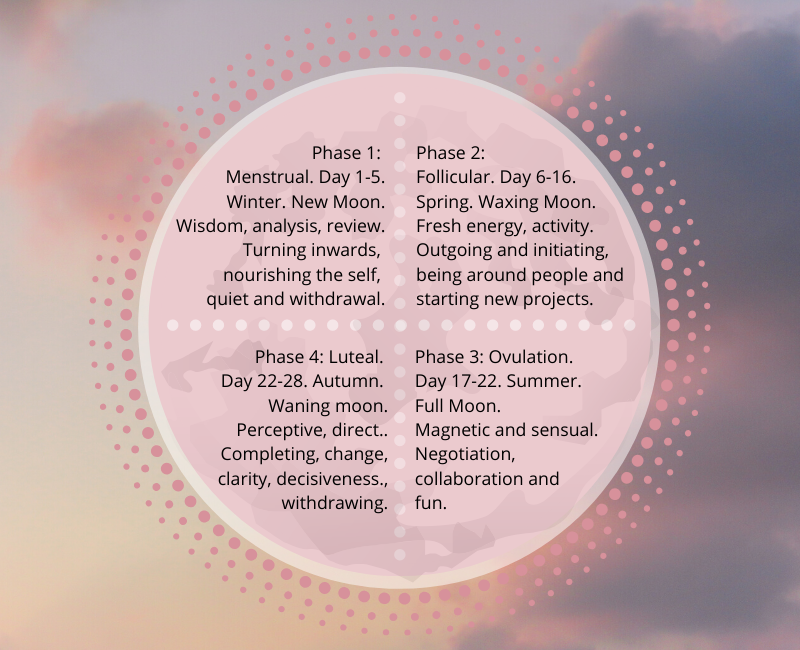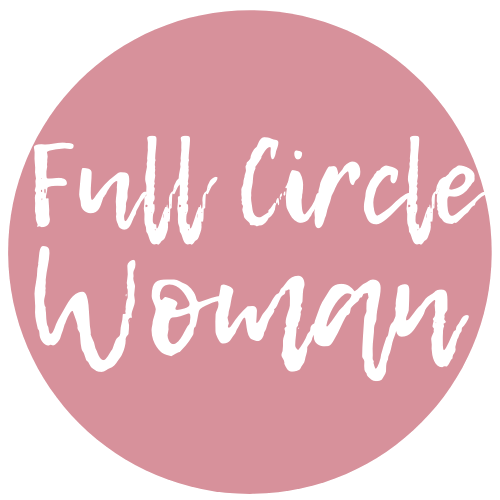Full Circle Woman: Lesson 1 Part 2
Tracking Your Cycle
Throughout the next 4 lessons we’ll be using the menstrual cycle as a framework. Before launching in to that, it’s important to familiarise ourselves with the phase of the menstrual cycle, and establish what to do if you are not experience a predictable cycle or not menstruating.
Everything in this course is good practice for women’s health in general, so if you are currently experiencing an absent or unpredictable period, don’t worry.
Irregular, painful, absent periods and difficulty in menstruation, ovulation, perimenopause and menopause are due to hormonal imbalance. When we experience discomfort, pain or unpleasant symptoms associated with our cycles, this is the body’s way of trying to alert us to what’s going on and compensate. Symptoms are helpful clues if we choose to take a proactive response and help us to know what we need to better support ourselves.
There are four phases to the cycle:
The menstrual phase – also known as the winter phase.
This is when your period happens. The first day of your period is day 1.
The follicular phase – also known as the spring phase.
This is when your period ends and your ovaries begin preparing an egg.
The ovulation phase – also known as the summer phase.
This is when your egg has matured and the phase in which you are fertile.
The luteal phase – also known as the autumn phase.
This when the body has detected you are not pregnant and prepares to start menstruation and clear and renew your womb for another cycle.

How to track
Pen and Paper
If you like to do things the old fashioned way, get yourself a diary that includes the moon phase on the pages. Add write in your last known period and pencil in your next expected period. Mark in how long your last period was. Block out 10 days from the last day of the period, 5 days after that for the ovulation phase and 5 days for the luteal.
Digitally
Apple now include cycle tracking with ovulation prediction in the Health app. I recommend MyFLO by Alissa Vitti, FLO living LLC, as the best period tracking app as it also includes eating and exercise prompts to support your cycle.
Basal Temperature
If your period is slightly irregular or you’re looking to prevent pregnancy or boost fertility. Measuring your basal temperature (the temperature you have when waking before getting up) provides excellent accuracy in predicting your ovulation date and period. Natural Cycles app takes the maths out of this, but it is subscription based. To get a discount you can use my referral code here:
If you don’t have a period or it’s too irregular to track
Use this practice in line with the moon phase.
Practice the menstrual phase work on the new moon.
The follicular phase work while the moon is waxing.
The ovulation phase work on the full moon.
The luteal phase work on the waning moon.
The practices often help to induce healthy menstruation naturally, so you may well find yourself back on track quicker than you thought!
If you have a ‘break through bleed’ using hormonal contraceptives
Technically speaking, hormonal contraceptives artificially stop your natural cycle. While your break through bleed may look and feel like a period, it’s not quite the same thing. None the less, for the purposes of the course, track a cycle as though the breakthrough bleed is a period.
Pausing your natural cycle for long stretches of time or from an early age with contraceptives may “put off” or hide the symptoms of reproductive health problems and hormonal imbalance. By taking on the practices this course suggests, you will set yourself up for an easier transition off your contraceptive when the time comes and have better reproductive health in the future.

